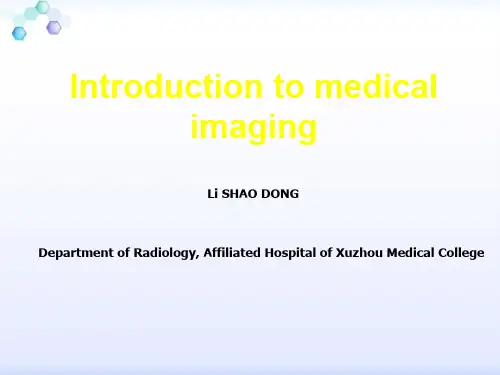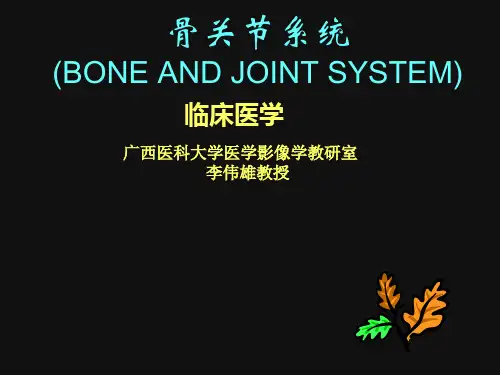医学影像学英文课件:Bone and joint X ray appearance
- 格式:ppt
- 大小:13.95 MB
- 文档页数:73

医学影像学英文课件Medical Imaging Course Slides1. Introduction to Medical ImagingMedical imaging is a broad field that encompasses various techniques used to visualize the internalstructures and functions of the human body. These techniques play a crucial role in the diagnosis, treatment, and monitoring of various medical conditions. The most commonly used medical imaging modalities include X-ray, computed tomography (CT), magnetic resonance imaging (MRI), ultrasound, and nuclear imaging.医学影像学是一个广泛的领域,包括各种用于可视化人体内部结构和功能的技术。
这些技术在诊断、治疗和监测各种医疗状况中发挥着关键作用。
最常用的医学影像模态包括X射线、计算机断层扫描(CT)、磁共振成像(MRI)、超声波和核医学成像。
2. X-ray ImagingX-ray imaging is one of the oldest and most widely used medical imaging techniques. It utilizes high-energy electromagnetic radiation to create images of the body's internal structures. X-rays are able to pass through thebody, and the degree of absorption by different tissues is used to create the image. This technique is particularly useful for visualizing bones, joints, and the chest cavity.X射线成像是最古老和最广泛使用的医学影像技术之一。

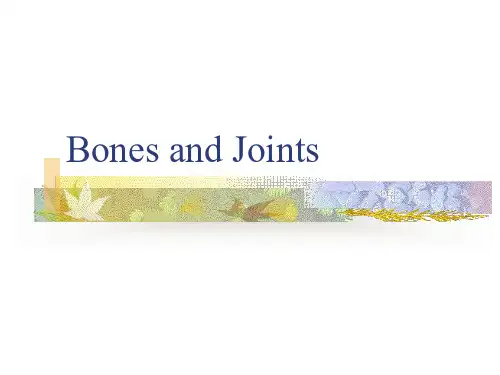
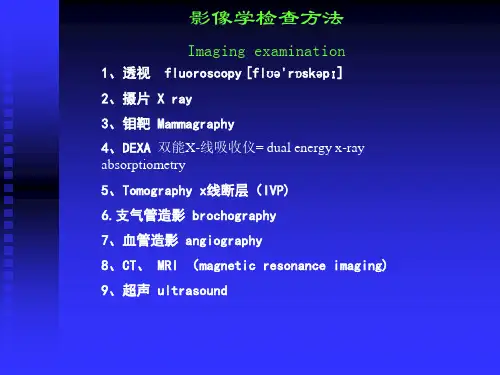
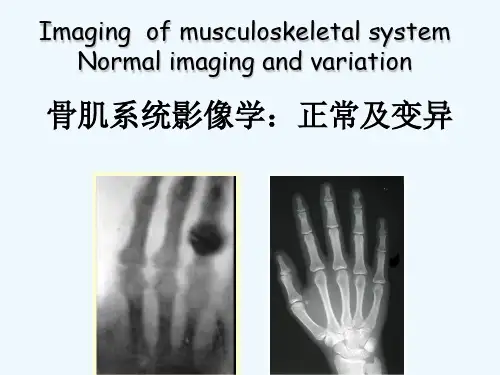

![最新[PPT]MedicalImaginginGeneral医学影像学总论讲学课件](https://uimg.taocdn.com/19c16728ce2f0066f43322b6.webp)
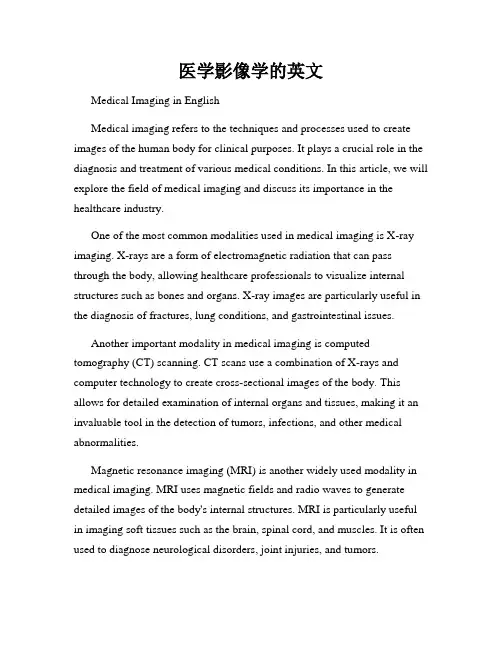
医学影像学的英文Medical Imaging in EnglishMedical imaging refers to the techniques and processes used to create images of the human body for clinical purposes. It plays a crucial role in the diagnosis and treatment of various medical conditions. In this article, we will explore the field of medical imaging and discuss its importance in the healthcare industry.One of the most common modalities used in medical imaging is X-ray imaging. X-rays are a form of electromagnetic radiation that can pass through the body, allowing healthcare professionals to visualize internal structures such as bones and organs. X-ray images are particularly useful in the diagnosis of fractures, lung conditions, and gastrointestinal issues.Another important modality in medical imaging is computed tomography (CT) scanning. CT scans use a combination of X-rays and computer technology to create cross-sectional images of the body. This allows for detailed examination of internal organs and tissues, making it an invaluable tool in the detection of tumors, infections, and other medical abnormalities.Magnetic resonance imaging (MRI) is another widely used modality in medical imaging. MRI uses magnetic fields and radio waves to generate detailed images of the body's internal structures. MRI is particularly useful in imaging soft tissues such as the brain, spinal cord, and muscles. It is often used to diagnose neurological disorders, joint injuries, and tumors.Ultrasound imaging, also known as sonography, uses sound waves to create images of the body's internal structures. Ultrasound is commonly used to visualize the fetus during pregnancy, as well as to assess the health of organs such as the heart, liver, and kidneys. Ultrasound is a safe and non-invasive imaging modality that is widely used in medical practice.Nuclear medicine is a specialized branch of medical imaging that uses radioactive substances to visualize and diagnose medical conditions. Techniques such as positron emission tomography (PET) and single-photon emission computed tomography (SPECT) are commonly used in nuclear medicine to detect diseases such as cancer, heart conditions, and neurological disorders.In addition to these modalities, medical imaging also encompasses a variety of other techniques such as fluoroscopy, mammography, and angiography. Each modality has its own strengths and limitations, and healthcare professionals must choose the most appropriate imaging technique based on the patient's condition and the clinical question at hand.The field of medical imaging is constantly evolving, with new technologies and techniques being developed to improve diagnostic accuracy and patient outcomes. Artificial intelligence (AI) and machine learning are increasingly being used in medical imaging to analyze images, detect abnormalities, and assist in diagnosis. These advances hold great promise for the future of medical imaging and have the potential to revolutionize healthcare delivery.In conclusion, medical imaging is an essential component of modern healthcare, providing healthcare professionals with valuable information todiagnose and treat medical conditions. From X-rays to MRI to nuclear medicine, the field of medical imaging offers a wide range of modalities to visualize the human body and provide insights into the underlying pathology. As technology continues to advance, the role of medical imaging in healthcare will only continue to grow in importance.。
